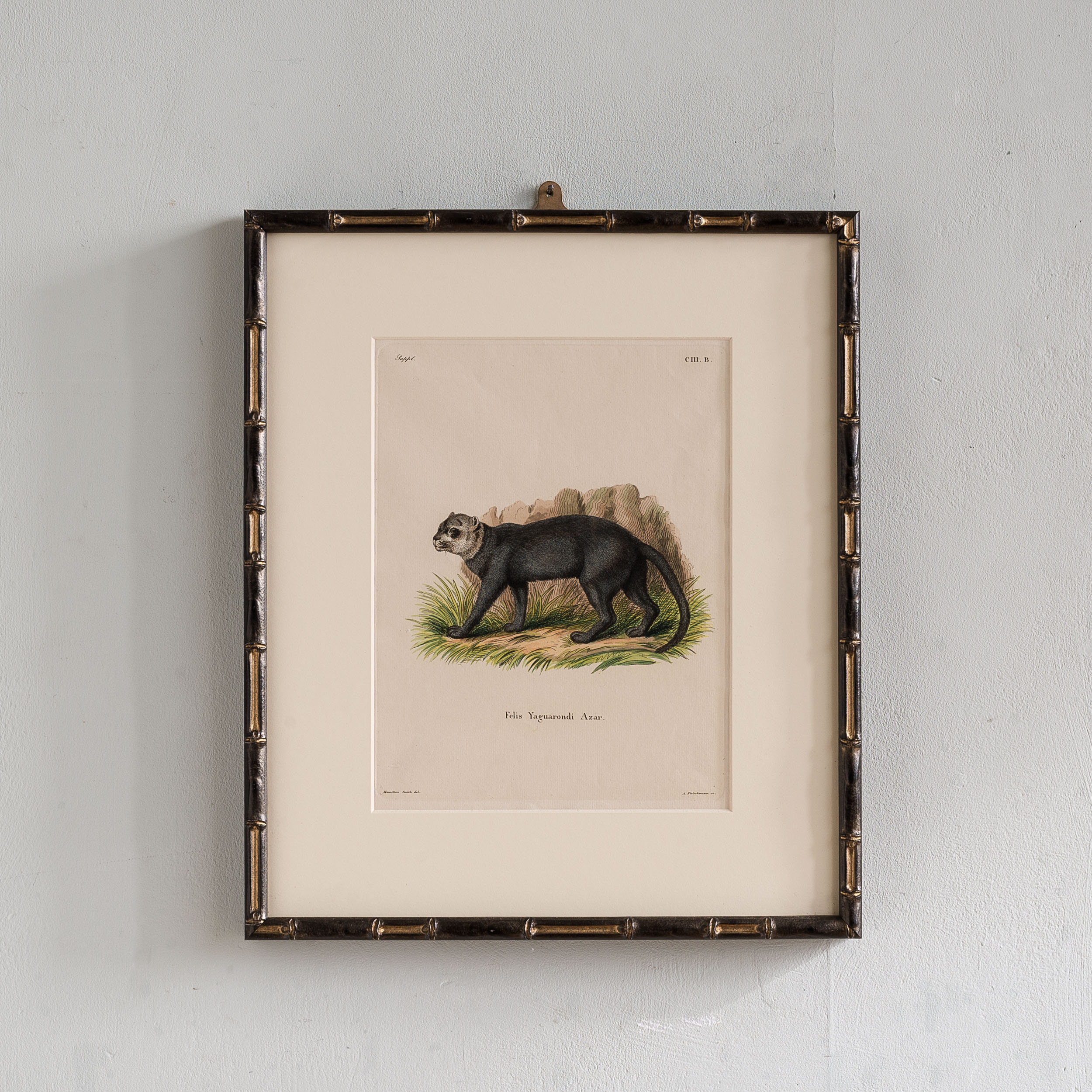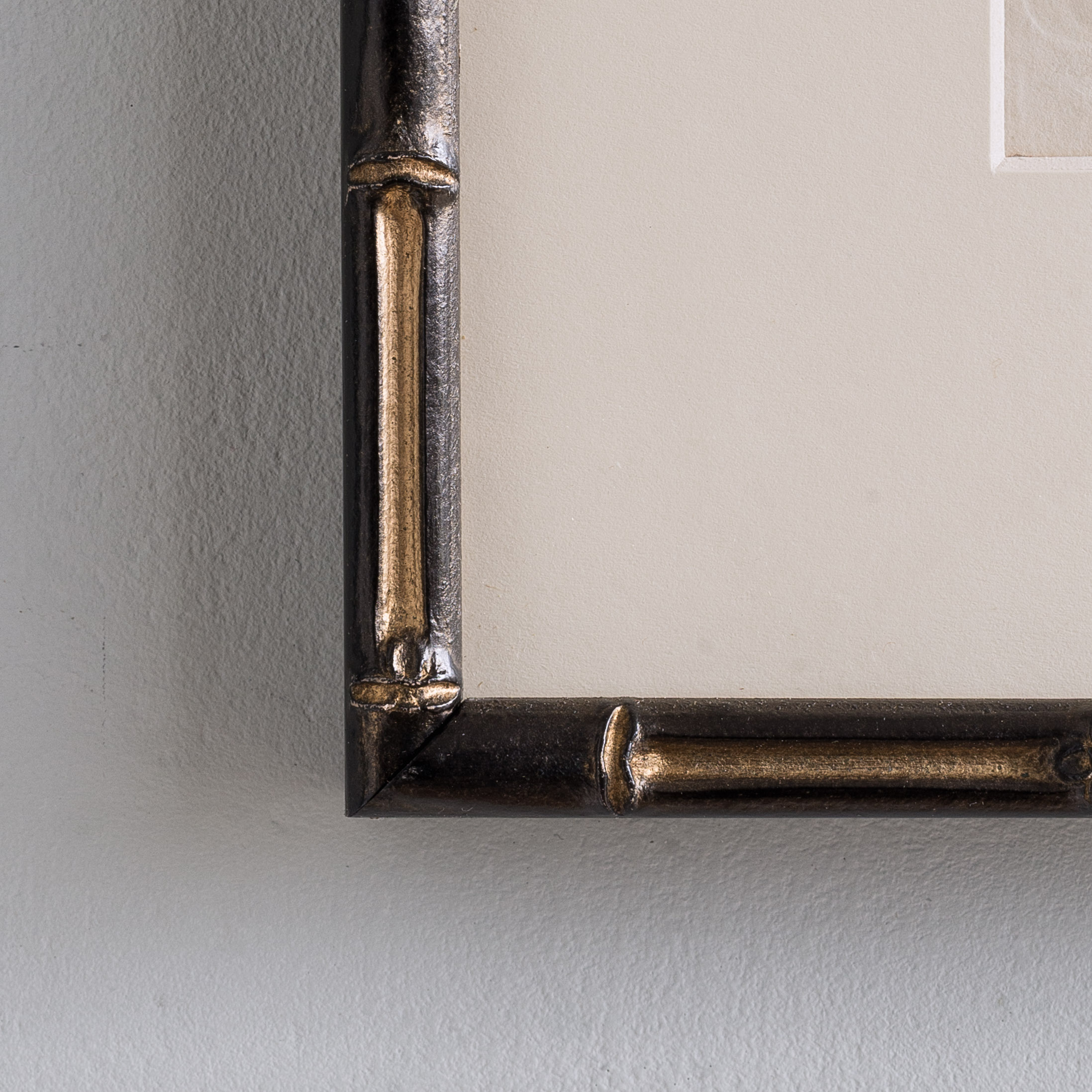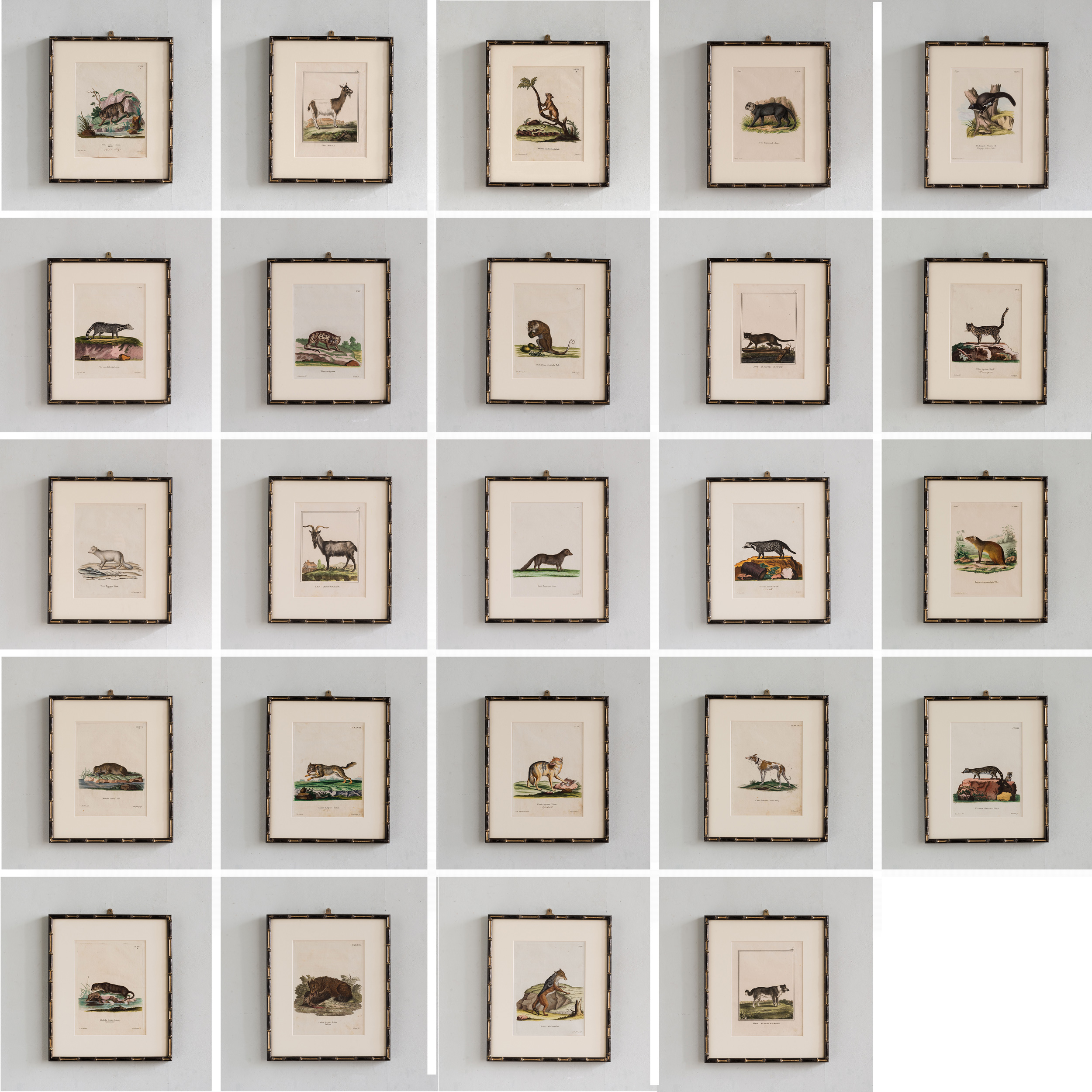De Buffon, 18th Century natural history,
Animal prints, based on he work of Georges-Louis Leclerc, count de Buffon, who attempted to systematically present all existing knowledge in the fields of natural history, geology, and anthropology in a single publication. Published c1740, Latin and German text. Presented in faux bamboo frames.
'Felis Yaguarondi Azar'.
£150 each
In stock
Buffon’s father, Benjamin Leclerc, was a state official in Burgundy; his mother was a woman of spirit and learning, and he was fond of saying that he got his intelligence from her. The name Buffon came from an estate that he inherited from his mother at about the age of 25. Beginning his studies at the College of Godrans in Dijon, which was run by the Jesuits, he seems now to have been only an average student, but one with a marked taste for mathematics. His father wanted him to have a legal career, and in 1723 he began the study of law. In 1728, however, he went to Angers, where he seems to have studied medicine and botany as well as mathematics. He was forced to leave Angers after a duel and took refuge at Nantes, where he lived with a young Englishman, the duke of Kingston. The two young men travelled to Italy, arriving in Rome at the beginning of 1732. They also visited England, and while there Buffon was elected a member of the Royal Society. The death of his mother called him back to France. He settled down on the family estate at Montbard, where he undertook his first research in the calculus of probability and in the physical sciences. Buffon at that time was particularly interested in questions of plant physiology. In 1735 he published a translation of Stephen Hales’s Vegetable Staticks, in the preface of which he developed his conception of scientific method. Maintaining an interest in mathematics, he published a translation of Sir Isaac Newton’s Fluxions in 1740. In his preface to this work he discussed the history of the differences between Newton and Gottfried Wilhelm Leibniz over the discovery of the infinitesimal calculus. He also made researches on the properties of timbers and their improvement in his forests in Burgundy. In 1739, at the age of 32, he was appointed keeper of the Jardin du Roi (the royal botanical garden, now the Jardin des Plantes) and of the museum that formed part of it through the patronage of the minister of marine, J.-F.-P. de Maurepas, who realized the importance of science and was anxious to use Buffon’s knowledge of timber for the shipbuilding projects of the French government. Maurepas also charged Buffon to undertake a catalog of the royal collections in natural history, which the ambitious Buffon transformed into an undertaking to produce an account of the whole of nature. This became his great work, Histoire naturelle, générale et particulière (1749–1804), which was the first modern attempt to systematically present all existing knowledge in the fields of natural history, geology, and anthropology in a single publication. Buffon’s Histoire naturelle was translated into various languages and widely read throughout Europe. The first edition is still highly prized by collectors for the beauty of its illustrations. Although Buffon laboured arduously on it—he spent eight months of the year on his estate at Montbard, working up to 12 hours a day—he was able to publish only 36 of the proposed 50 volumes before his death. In the preparation of the first 15 volumes, which appeared in 1749–67, he was assisted by Louis J.M. Daubenton and several other associates. The next seven volumes formed a supplement to the preceding and appeared in 1774–89, the most famous section, Époques de la nature (1778), being contained in the fifth of them. They were succeeded by nine volumes on birds (1770–83), and these again by five volumes on minerals (1783–88). The remaining eight volumes, which complete the first edition, were done by the count de Lacépède after Buffon’s death; they covered reptiles, fishes, and cetaceans. To keep the descriptions of the animals from becoming monotonous, Buffon interspersed them with philosophic discussions on nature, the degeneration of animals, the nature of birds, and other topics.
He was elected to the French Academy, where, on August 25, 1753, he delivered his celebrated Discours sur le style (“Discourse on Style”), containing the line, “Le style c’est l’homme même” (“The style is the man himself”). He was also treasurer to the Academy of Sciences. During the brief trips he made each year to Paris, he frequented the literary and philosophical salons. Although he was a friend of Denis Diderot and Jean Le Rond d’Alembert, he did not collaborate on their Encyclopédie. He enjoyed his life at Montbard, living in contact with nature and the peasants and managing his properties himself. He built a menagerie and a large aviary there and transformed one of his outbuildings into a laboratory. Buffon’s wife died in 1769, leaving him with a five-year-old son. The boy showed signs of brilliance, and when he was 17 Buffon asked the naturalist J.-B. Lamarck to take him along on his botanical travels across Europe. However, the younger Buffon was not interested in study. He developed into a spendthrift, and his imprudence eventually led him to the guillotine during the French Revolution (1794). In 1785 Buffon’s health began to decline. At the beginning of 1788, feeling his end near, he returned to Paris. Unable to leave his room, he was visited each day by his friend Mme Necker, the wife of the finance minister Jacques Necker. Mme Necker, who was with him to the very end, is said to have understood him to murmur, “I declare that I die in the religion in which I was born. . . . I declare publicly that I believe in it.” Buffon’s position among his contemporaries was by no means assured. Though the public was nearly unanimous in its admiration of him, he met with numerous detractors among the learned. The theologians were aroused by his conceptions of geological history; others criticized his views on biological classification; the philosopher Étienne de Condillac disputed his views on the mental faculties of animals; and many took from his work only some general philosophical ideas about nature that were not faithful to what he had written. Voltaire did not appreciate his style, and d’Alembert called him “the great phrasemonger.” According to the writer J.-F. Marmontel, Buffon had to put up with snubs from the mathematicians, chemists, and astronomers, while the naturalists themselves gave him little support and some even reproached him for writing ostentatiously in a subject that required a simple and natural style. He was even accused of plagiarism but made no reply to his detractors, writing to a friend that “I shall keep absolute silence . . . and let their attacks fall upon themselves.” In some areas of natural science Buffon had a lasting influence. He was the first to reconstruct geological history in a series of stages, in Époques de la nature (1778). With his notion of lost species he opened the way to the development of paleontology. He was the first to propose the theory that the planets had been created in a collision between the Sun and a comet. While his great project opened up vast areas of knowledge that were beyond his powers to encompass, his Histoire naturelle was the first work to present the previously isolated and apparently disconnected facts of natural history in a generally intelligible form. Buffon’s writings are collected in Oeuvres complètes de Buffon, 12 vol. (1853–55), revised and annotated by Pierre Flourens.



